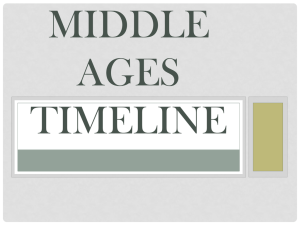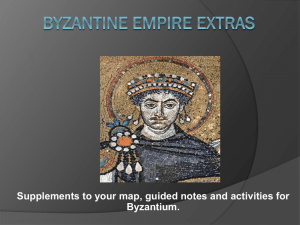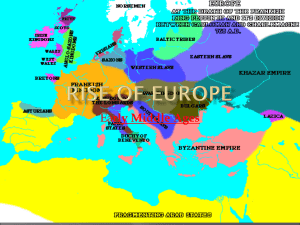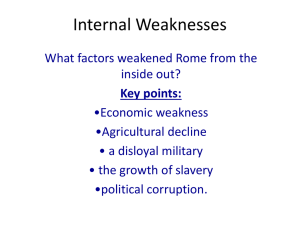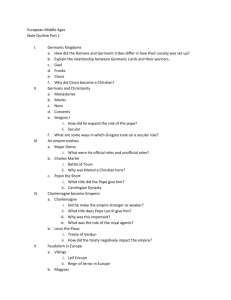Why did Alaric attack the city of Rome in 408? What motivated him
advertisement
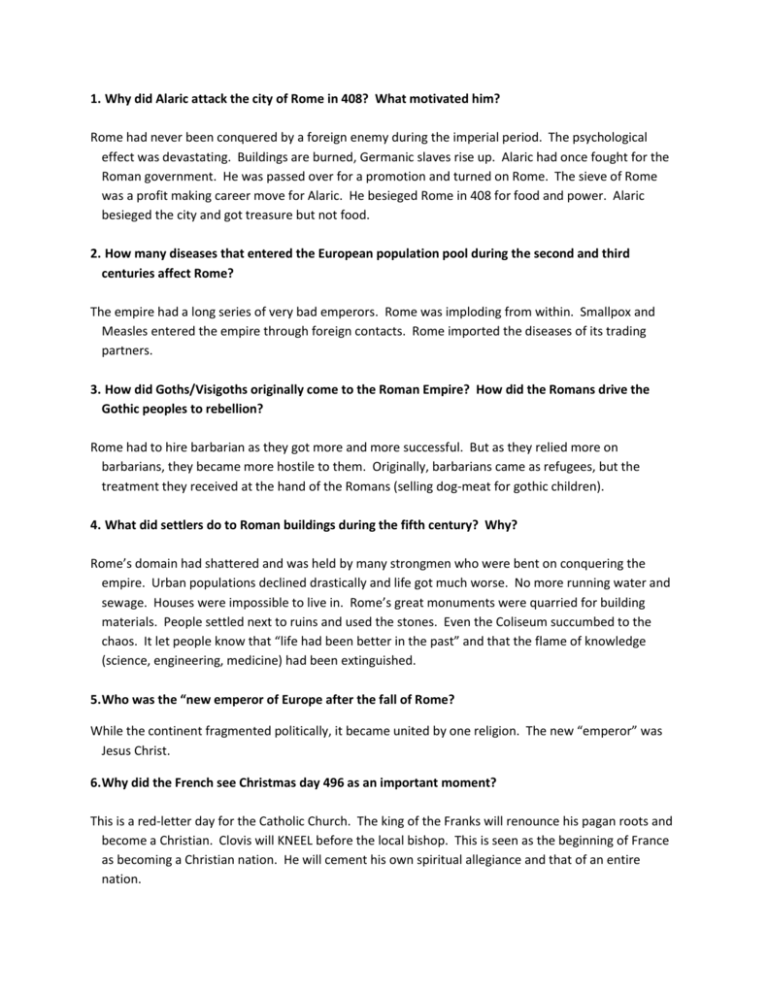
1. Why did Alaric attack the city of Rome in 408? What motivated him? Rome had never been conquered by a foreign enemy during the imperial period. The psychological effect was devastating. Buildings are burned, Germanic slaves rise up. Alaric had once fought for the Roman government. He was passed over for a promotion and turned on Rome. The sieve of Rome was a profit making career move for Alaric. He besieged Rome in 408 for food and power. Alaric besieged the city and got treasure but not food. 2. How many diseases that entered the European population pool during the second and third centuries affect Rome? The empire had a long series of very bad emperors. Rome was imploding from within. Smallpox and Measles entered the empire through foreign contacts. Rome imported the diseases of its trading partners. 3. How did Goths/Visigoths originally come to the Roman Empire? How did the Romans drive the Gothic peoples to rebellion? Rome had to hire barbarian as they got more and more successful. But as they relied more on barbarians, they became more hostile to them. Originally, barbarians came as refugees, but the treatment they received at the hand of the Romans (selling dog-meat for gothic children). 4. What did settlers do to Roman buildings during the fifth century? Why? Rome’s domain had shattered and was held by many strongmen who were bent on conquering the empire. Urban populations declined drastically and life got much worse. No more running water and sewage. Houses were impossible to live in. Rome’s great monuments were quarried for building materials. People settled next to ruins and used the stones. Even the Coliseum succumbed to the chaos. It let people know that “life had been better in the past” and that the flame of knowledge (science, engineering, medicine) had been extinguished. 5. Who was the “new emperor of Europe after the fall of Rome? While the continent fragmented politically, it became united by one religion. The new “emperor” was Jesus Christ. 6. Why did the French see Christmas day 496 as an important moment? This is a red-letter day for the Catholic Church. The king of the Franks will renounce his pagan roots and become a Christian. Clovis will KNEEL before the local bishop. This is seen as the beginning of France as becoming a Christian nation. He will cement his own spiritual allegiance and that of an entire nation. 7. What were Clovis’ political reasons for converting to Christianity? Clovis united his people under one “ruler” who was beyond question. Warfare was endemic and civil war broke out often. By aligning himself with God, Clovis could rule unquestioned. Christianity was the only common thread uniting people in France. Christianity offered the hope of eternal peace. He knew that the way to his subjects’ hearts was through their souls. Clovis used religion to justify war as a defense of Christianity. Clovis is the founder of the Merovingian line. Not in film: Clovis’ wife was already a Christian and was a very wealthy heiress. The Church approved of their marriage on the condition that Clovis convert. Clovis not only gained money and land (from his wife) but he also gained the ear of the Bishop of Rome. 8. What was happening in Byzantium between 527 and 540 AD? What was Justinian doing? Did he build anything significant? In the East, the light of the Roman Empire burned bright. Around 530 AD, Roman soldiers mark out of Constantinople in order to reconquer the lost lands to the West. Late in the 3rd century, the empire had been split. However, this left the Latin west in rough shape. The wealth of the East had been used to prop up the West for centuries. After the fall of Rome, Constantinople was doing just fine. Justinian was from humble roots, but was incredibly greedy and used much trickery to raise money. At a chariot race (Nika Riot) citizens rioted against the emperor and sacked the city. Empress Theodora refused to leave the city with Justinian. Thirty thousand rioters were killed and then Justinian had all of his political enemies killed. Everything was set for them to succeed. The emperor was very successful in re-conquering the West. In the Italian campaign, entire cities were wiped out. It was one of the worst campaigns in the ancient world. While the West was falling, Justinian was building Hagia Sophia. It had the best of everything in a church (architecture, gold leaf, mosaics). The church had an incredible visual impact and elevated Justinian to the height of someone “biblical”. Justinian was eventually defeated by the bubonic plague. Within three days of contact. Most victims were dead. The plague came in from flees on rats (sound familiar?). A small percentage of those infected managed to survive. However, the illness permanently scarred his mind and body. About half of the empire’s population (1 million people) died. At least a third of the population in most cities died (spread as far as Spain, France and Ireland). It took hundreds of years for the population to recover. Pockets of plague would re-appear in later centuries. 9. What happened in the Byzantine Empire in 542 AD? As soon as Justinian dies, the Byzantine Empire realizes it cannot hold on to Western Europe. It became insular and all but ignored the west. Life for most Europeans became nasty, brutish and short. With the final withdrawal of Justinian’s troops, Europe was divided by war-lords. Trade declined and the economy became strictly agricultural. Things were just like they were before Roman conquest. Stories of magic and ghosts became real to many people. This is when the legend of Arthur was born. 10. What was the work pattern for most people during the Dark Ages? You worked according to seasonal patterns. No work in the winter and frantic activity (dawn to dusk) in spring and summer (planting and harvest). Everyone who could walk worked. 11. What was the percentage of people why die before adulthood? About half of children died before adolescence and ¼ of newborns died before the age of one. Most children experienced the loss of one or both parents before they reached adulthood. These numbers will skew “average age at death” and make it much younger that it should be. 12. What is the significance of the monk Bede? The only light of the Dark Ages shone from monasteries. They were centres of commerce, political and religious authority. In Yarrow, St. Bede writes a history of England from Roman conquest to present day. Monks preserved manuscripts (Virgil, Homer, etc). One didn’t want to like pagan works too much, but Bede’s library of 150-ish books was impressive. Monasteries were the keepers of knowledge. 13. What is the significance of St. Benedict? He was a key figure in monasticism. He had a reputation for sanctity and healing. Recognizing Benedict’s rising fame, he was asked to become an abbot for a monastery. However, his ideas of discipline were not popular with the monks. The monks tried to poison him twice (and failed). He established his own monasteries and challenged his monks to live under his RB 14. Why do you think his Rule was so useful in monasteries? It allowed monks to eliminate their own will (putting your desired back). Thousands of men and women escaped to monasteries for a variety of reasons. Religious life became a heavy cross to bear. The RB was useful because it established order in monasteries and could be applied equally to all who entered (throughout Europe). It became easier for religious authorities to spot wayward monasteries and bring them back in line with what was considered “acceptable”. Interesting side note: the RB is still followed today. You wake at 2AM to pray, then again at around 6:30, eat, and go to work and then Mass at 9:00. Pray together at noon and three in the afternoon, then eat diner, pray (again) and go to sleep. There was little meat and wine, but monks had plenty of beer. In fact, they became famous for brewing beer. Eventually monks started to make wine as well (they invented champagne). 15. What new religion spread through the Middle East and Africa by 730 AD? The religion is Islam. The Prophet Mohammed began the religion around 640 AD and it spread very quickly. Within 100 years, Islam was the official religion of everyone living from Morocco to Iraq. Think about that, it took Christianity 300 years just to become legal. 16. How do you think Europe was affected by the Moorish invasion of Spain and their attack on France in the eighth century? They saw the Moors as an immediate and local threat to their world order. There was a religious mission on both sides of the conflict. 17. What is the significance of Charles Martel? What is the significance of his grandson? Charles Martel defeated the Christian Franks against the Moors in 732 AD. Aquitaine and Gascony were devastated. Charles Martel was ready for the Moors’ attack. He was commander in chief of the Frankish Army. He convinced farmers to become soldiers. Martel needed full-time soldiers who were trained well. He got money from the Church and used it to finance an army (almost got excommunicated). Charles took the high ground and the two generals faced off for six days. On the seventh day, Rachman ordered the attack. Charles Martel sent some troops to the Muslim camp behind the battle lines. Many Moors retreated to defend the tents and many more thought that a general retreat had been called. Rachman was killed and Charles earned the nicknamed “Martel” or “The Hammer”. 18. How did Charlemagne divide up the empire? How did he supervise these 350 units? He divided his empire into counties and assigned a count to each one of them. He traveled constantly and visited them regularly. 19. How did Charlemagne rekindle learning in Europe? Charlemagne was the greatest king of the Dark Ages. He was crowned on Christmas Day 800 by the Pope. Irene was in charge of Byzantium. Not since the fall of Rome had so much of the continent been under one man. But the size of the Charlemagne’s empire is the only thing it had in common with Rome’s empire. Charles launched more than 50 military campaigns. They increased his territory and created converts. Charlemagne believed himself to be like the kings of the ancient world (culture, culture, culture). He built royal schools for ALL. Even Charlemagne learned how to read and write. Charlemagne’s schools were all linked to monasteries. As the Church grew, so did culture. 20. How did what happened in Lindisfarne, England on June 8, 793 change history? The sack of Lindisfarne by the Vikings was “the wrath of Satan inflicted on a house of God”. The raid was savage and marked the start of the Viking Age. The greatest wealth of England was stored in its churches. Churches have tall steeples. They were like giant “gold here, rob here” signs. Carolingians had begun to pay the Vikings protection money. One even gave the Viking “Rollo” land in France. This is where the “northmen” settled and it is Northman or Norman land. Today, we call this land Normandy. Vikings controlled a vast empire, this is why the Norman kingdom controlled Sicily and even parts of the Middle East (PRE-CRUSADE). 21. How did Alfred the Great defend his kingdom from the Vikings? He was attacked by Vikings and refused to crumble. Alfred realized that the Vikings liked to raid (blitzkrieg). Alfred built fortresses and the Vikings did not have the siege technology to attack them. Alfred let the Vikings wear themselves out and then he attacked them. After 25 years, he was successful. Many Vikings then settled in with local communities and merged. 22. What two edicts did the Church issue in the 10th century to curb knightly violence? The end of the Viking age did not trigger the end of the Dark Ages. Thugs in tin cans were the new threat. Knights have more in common with Tony Soprano than they did with Lancelot. The Catholic Church used the clothes, bones, and relics of saints. They would summon knights and made the knights swear to obey the Peace and Truce of God (or else the saints would come after them). Peace of God proclaimed that certain individuals (defenseless) should not be attacked by knights Truce of God proclaimed that certain periods (Lents, Sundays) should be without knightly violence. 23. What lands did the Church tell knights they could invade in 1095? The Holy Land (Bethlehem and Jerusalem). They were bad at geography, so they tried to conquer the large swaths of land around these cities. Urban II called for the first crusade at Clarendon. 24. Why do the Crusades mark the end of the Dark Ages in Europe? The Crusades were a “vengeance” on behalf of Jesus. The Crusaders returned with knowledge, books, languages, even Aristotle. Europe turned the corner. Medical and surgical information comes too. The Crusades spawned a rebirth of trade and architecture. Roads and military supply lines are used for trade. There was also a warming of Europe that started around the year 1000. There was a population boom (town walls grow). Europe is on the verge of Gothic Cathedrals and the rise of the university system. The Dark Ages are a supposed cultural void between Rome and the Gothic Middle Ages of Richard the Lionhearted and Robin Hood. The dawning of medieval Europe could only happen after a long and dark night.
